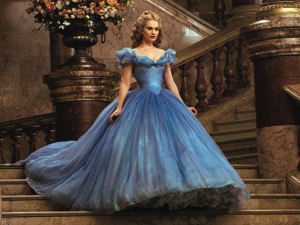
Sometimes, you have to do it straight. I don’t mean that you need to be heterosexual – perish the thought – but rather that you sometimes need to resist the temptation to change a classic. You don’t have to set Hamlet in 21st century Manhattan, sing “Billie Jean” as a guitar ballad, turn Hansel and Gretel into paramilitary witch hunters or make Sleeping Beauty a story about a broken-hearted fairy and not a wronged princess. The new interpretation can be fun, fascinating, even fantastic, but in our embrace of this postmodern twist on an old reliable we can sometimes forget why the old was reliable.
Cinderella, one of the most indelible of Western fairy tales, has been reinterpreted countless times since it first appeared in print in the 17th century; but mostly the story stays true to its origins: a wealthy girl is turned into a servant by a horrible stepmother and a fairy godmother helps the girl win the heart and hand of a charming prince. The animated Disney version released in 1950 is the most famous, and its story structure, characters and lyrics from its songs are so iconic that most people cannot think of Cinderella without thinking of Gus the mouse, the wicked stepsisters Drisella and Anastasia, and “Bibbidi-Bobbidi-Boo.” While Disney’s Sleeping Beauty was wildly reimagined into the commercially successful but artistically and thematically messy Maleficent, with Disney’s massively budgeted live action version of Cinderella, they didn’t stray more than a few inches from the source material. And the result is an instant classic.
The plot should be familiar to most of us. In a small nameless kingdom, Ella (Lily James, with Eloise Webb as a young girl) is the beautiful and happy only daughter of a kind and wealthy trader (Ben Chaplin) and his perfect wife (Hayley Atwell). Their utopian family is ruptured when Ella’s mother dies; before she does, she tells Ella that she must always have courage and be kind. With this mantra and motto in her head and tittering mice as her only friends, she tries to make the best of her snide stepmother (Cate Blanchett) and ridiculously vapid stepsisters (Sophie McShera and Holliday Grainger), even after her father dies and these interlopers set out to ruin Ella’s life.
Meanwhile, the kingdom’s prince (Richard Madden) is being pressured to find a bride as his father (Derek Jacobi) is dying. The rest of the story is probably embedded in your brain whether you like it or not.
The basics of the film are lifted from the 65-year-old animated version, but Chris Weitz’s screenplay modernizes some of the more retrograde politics. There are multiple non-white characters, though not among the leads. Cinderella is a bold girl who speaks her mind, rather than a pretty victim of circumstance; James, best known as the similarly feisty Lady Rose in Downton Abbey, is perfectly cast. And the wicked stepmother is given real psychological motivation for her behavior. She is a woman ruined by her need for men to take care of her. This gives Blanchett ample space to be both hilariously bitchy and justifiably desperate, even sympathetic.
Various jokes, noticeable probably only to adults in the audience, show a certain level of irony to the proceedings, but most of the script is decidedly earnest. This suits director Kenneth Branagh’s talents. He is contemporary film’s great director of Shakespeare, and his reverence to and skill with classicism gives the story’s great moments – the majesty of the ball, the beauty of the slipper, the enchantment of the fairy godmother’s spells and the epic nature of the prince and Ella’s love – emotional heft that I couldn’t imagine could come from such an old story.











